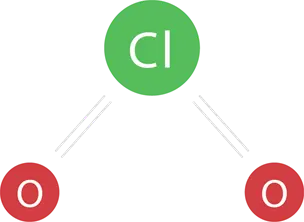Due to its radical structure, Chlorine Dioxide has a particular reactivity – different from chlorine or ozone.
The electrophilic nature of chlorine or hypochlorous acid can lead, through reaction of addition or substitution, to the formation of organic species while the radical reactivity of chlorine dioxide mainly results in oxycarbonyls.
Generally, Chlorine Dioxide (ClO2) rapidly oxidises phenol-type compounds, secondary and tertiary amines, organic sulphides and certain hydrocarbon polycyclic aromatics such as benzopyrene, anthracene and benzoathracene.
In general, Chlorine Dioxide will not react on double carbon bonds, aromatic cores, quinionic and carboxylic structures, primary amines, and urea.
Commercial applications have shown that Chlorine Dioxide can effectively oxidise many compounds considered waste and water pollutants. The table below lists a selection of pollutants found in various industries from our files and demonstrates the wide range of possible applications for Chlorine Dioxide. Scotmas possesses over 25 years of application expertise in chlorine dioxide technology in challenging applications.
